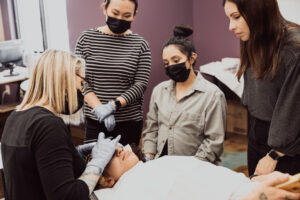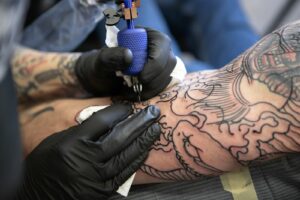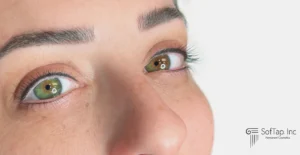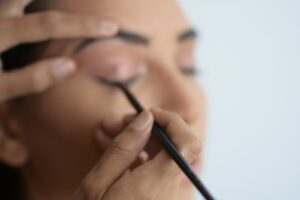Tattoo vs. Permanent Makeup: What’s the difference in pigment?
In the world of aesthetics, the distinction in tattoo vs permanent makeup is often debated, particularly when it comes to the types of pigments used. At Cameo College, where we specialize in teaching permanent cosmetics, understanding these differences is crucial for any aspiring permanent makeup artist. This article delves into the definition, history, and common applications of tattoos and permanent makeup, highlighting their unique characteristics.
Understanding Tattoo vs Permanent Makeup

Definition of Tattoo vs Permanent Makeup
A tattoo is a form of body art where tattoo ink is injected deep into the skin using a tattoo machine, creating a permanent design or image. Permanent makeup, or PMU, is a specialized form of tattooing used for cosmetic purposes, often on the face. It involves the use of pigments specifically designed for creating various effects. Some of these include:
- Permanent eyeliner
- Eyebrow enhancements
- Lip tattoos
History of Tattoo vs Permanent Makeup
Tattoos have a long and storied history, dating back thousands of years as a form of cultural expression and personal adornment. Permanent makeup, however, is a relatively recent innovation, emerging in the 20th century. It was developed to offer a semi-permanent cosmetic solution, enhancing facial features with precision and artistry, using specially formulated permanent makeup pigments.
Common Uses and Applications

Photo by benjamin lehman on Unsplash
Traditional tattoos are often used to create detailed body art, featuring intricate designs and vivid colors. They cover a wide array of artistic expressions and are applied using tattoo ink and a coil or rotary tattoo machine.
In contrast, permanent makeup is primarily used on the face, utilizing pigments for subtle enhancements. Here are some common applications:
- Eyebrow microblading
- Lip blush
- Eyeliner
These techniques use pigments and methods designed for a natural look.
Differences in Pigment

Composition of Tattoo vs Permanent Makeup Pigments
The composition of tattoo ink and permanent makeup pigments is a crucial area of differentiation. Here are some key differences between the two:
- Tattoo ink is typically composed of a wide range of dyes and pigments suspended in a carrier solution, designed to inject deep into the skin for vibrant and lasting body art.
- Permanent makeup pigments are specifically designed for facial application, often containing iron oxide for a more natural appearance and gradual fading over time.
Color Longevity and Fading
Color longevity is another key difference between tattoo ink and permanent makeup pigments. Traditional tattoos, with their regular tattoo ink, are intended to last a lifetime, maintaining their color and detail with minimal fading. Meanwhile, permanent makeup is semi-permanent; the pigments used are formulated to fade gradually. This allows for adjustments and changes over time, particularly as facial features and cosmetic preferences evolve.
Skin Reactions and Sensitivities
Skin reactions and sensitivities can vary significantly between tattoos and permanent makeup. Regular tattoo ink, injected deep into the skin, can sometimes cause allergic reactions or sensitivities due to its diverse ingredients. Permanent makeup pigments are formulated to be gentler, minimizing the risk of adverse reactions. This is crucial for applications on sensitive facial areas, where even minor irritation can affect the final cosmetic result.
Cosmetic Tattoos: A Closer Look

Photo by Chalo Garcia on Unsplash
What is PMU and Its Benefits?
Permanent makeup, or PMU, is a specialized form of cosmetic tattooing that focuses on enhancing facial features. The benefits of PMU include convenience, as it reduces the need for daily makeup application, and precision, offering natural-looking enhancements like permanent eyeliner, eyebrow microblading, and lip blush. These cosmetic tattoos are crafted using pigments and techniques that cater specifically to the delicate nature of facial skin.
Techniques Used by Tattoo Artists for Permanent Makeup
Tattoo artists specializing in permanent makeup employ various techniques to achieve desired results. For instance, microblading involves using fine needles to apply pigment strokes that mimic natural eyebrow hairs. Rotary and coil tattoo machines may be used for broader shading applications, such as lip tattoos or eyeliner. Each technique is carefully executed to ensure a natural look, utilizing pigments that complement the individual’s skin tone.
Choosing the Right Pigments for Cosmetic Applications
Choosing the right pigments for cosmetic applications is vital for achieving satisfactory results in permanent makeup. PMU pigments are specifically designed to offer a range of colors that suit different skin tones and preferences. A skilled permanent makeup artist understands the importance of selecting pigment particles that blend seamlessly with the natural complexion, ensuring the final result is both aesthetically pleasing and long-lasting.
The Process: From Consultation to Aftercare

Photo by Antoni Shkraba Studio on Pexels
Consultation: Understanding Client Needs
The consultation phase is a critical step in the permanent makeup process, where the permanent makeup artist gathers vital information about the client’s needs and expectations. During this stage, the artist discusses the difference between permanent makeup and traditional tattoos, ensuring the client understands the semi-permanent nature of PMU. A thorough assessment of skin type, desired cosmetic tattoo effects, and pigment choice is conducted to create a personalized plan.
The Application Process of Permanent Makeup
The application process of permanent makeup involves the precise use of a rotary or coil tattoo machine to implant pigments just beneath the skin’s surface. Unlike traditional tattoos where tattoo ink is injected deep into the skin, PMU pigments are applied to a shallower layer, allowing for natural fading over time. Techniques like microblading for eyebrows or permanent eyeliner require skilled manipulation of needles used for permanent makeup, ensuring subtle and precise results.
Aftercare for Tattoo vs Permanent Makeup
Aftercare is a crucial component for both tattoos and permanent makeup, but the requirements differ significantly. For regular tattoos, the focus is on healing the deeper layers of skin where the ink is injected. In contrast, permanent makeup aftercare emphasizes protecting the delicate facial skin and ensuring the pigments used for permanent makeup settle correctly. Clients are advised on specific care routines, including avoiding sun exposure and using gentle cleansers to prolong the cosmetic results.
Final Thoughts: Making the Right Choice

Photo by kvrkchowdari on Pixabay
Evaluating the Pros and Cons
Choosing between permanent makeup and regular tattoos requires evaluating the pros and cons based on individual needs and lifestyle. Permanent makeup offers convenience and time-saving benefits, reducing the need for daily cosmetic application. However, its semi-permanent nature means touch-ups may be necessary over time. Regular tattoos, on the other hand, provide permanent body art but lack the subtlety and natural look specifically designed for facial cosmetic purposes.
When to Choose Permanent Makeup Over Regular Tattoo
Permanent makeup is ideal for individuals seeking subtle enhancements to their facial features, such as permanent eyeliner, lip blush, or eyebrow microblading. Unlike regular tattoos, PMU is specifically designed to blend seamlessly with natural skin tones, offering a gentle enhancement rather than a bold statement. Those who value convenience and wish to maintain a natural appearance often opt for PMU over traditional tattoos.
Future Trends in Pigments and Permanent Makeup
The future of permanent makeup is set to evolve with advancements in pigments and techniques. Innovations in pigment particles and formulations, including the use of iron oxide, are enhancing the longevity and safety of PMU applications. Additionally, trends such as machine-assisted application methods promise more precise results. As the demand for natural-looking cosmetic enhancements grows, the permanent makeup industry continues to adapt, offering versatile solutions for today’s beauty needs.

